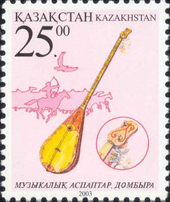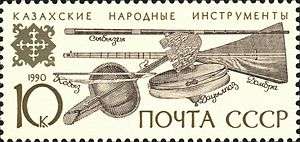Music of Kazakhstan
Music of Kazakhstan refers to a wide range of musical styles and genres deriving from Kazakhstan. Kazakhstan is home to the Kazakh State Kurmangazy Orchestra of Folk Instruments, the Kazakh State Philharmonic Orchestra, the Kazakh National Opera and the Kazakh State Chamber Orchestra. The folk instrument orchestra was named after Kurmangazy Sagyrbayuly, a well-known composer and dombra player from the 19th century.
| Music of Central Asia |
|---|
Traditional music
Traditional music in Kazakhstan often refers to music of the following genres:
- Instrumental music, with the pieces ("Küy") being performed by soloists. Text is often seen in the background (or "program") for the music, as a lot of Küy titles refer to stories.
- Vocal music, either as part of a ceremony such as a wedding (mainly performed by women), or as part of a feast. Here we might divide into subgenres: epic singing, containing not only historical facts, but as well the tribe's genealogy, love songs, didactic verses; and as a special form the composition of two or more singers in public (Aitys), of dialogue character and usually unexpectedly frankly in content.
Russian and Soviet-era music

The Russian influence on the music life in Kazakhstan can be seen in two spheres:
- First, the introduction of musical academic institutions such as concert houses with opera stages, conservatories (where European music was performed and taught).
- Second, by trying to incorporate Kazakh traditional music into these academic structures.
Controlled by the Russian Empire and then the Soviet Union, Kazakhstan's folk and classical traditions became connected with ethnic Russian music and Western European music. Prior to the 20th century, Kazakh folk music was collected and studied by ethnographic research teams including composers, music critics and musicologists. In the first part of the 19th century, Kazakh music was transcribed in linear notation. Some composers of this era set Kazakh folk songs to Russian-style European classical music.
Kazakh musicians themselves, however, did not write their own music with notation until 1931. Later, as part of the Soviet Union, certain Kazakh folk culture was encouraged to avoid political and social unrest. The result was a derivative of Kazakh folk music. In 1920, Aleksandr Zatayevich, a Russian official, created major works of art music with melodies and other elements from Kazakh folk music. Beginning in 1928 and accelerating in the 1930s, he also adapted traditional Kazakh instruments for use in Russian-style ensembles (such as increasing the number of frets and strings). Soon, these styles of modern orchestral playing became the only way for musicians to officially play; Kazakh folk was turned into patriotic, professional and socialist endeavors.[1]
Musical institutions
The Musical-Dramatic Training College, founded in 1931, was the first institute of higher education for music in Kazakhstan. Two years later, the Orchestra of Kazakh Folk Musical Instruments was formed[1] The Foundation Asyl Mura is archives and publishes historical recordings of Kazakh music both traditional and classical. The Qurmanghazy Conservatoire is considered one of the leading conservatoires in Almaty.
Musical traditional instruments

The most popular traditional instruments are string instruments. First of them is the dombra (домбыра), the most popular and the oldest Kazakh music instrument. Some argue that nomads have used similar two-string instruments more than two thousand years ago.[2] The dombra is a long-necked lute with two strings tuned in the interval of a fourth or sometimes a fifth. The strings are plucked or strummed by the right hand without a plectrum.
The other instrument playing an important role is the Qobyz, which is a bowed instrument held between the legs. It is made of carved wood for the body, animal skin for the resonator, and horse hair for the strings, and the bow. The Qobyz is said to have been invented by the legendary shaman Qorqyt, long before the medieval ages. The "Zhetigen" ("Seven strings") could be seen as a member of the cither family, finding equivalents in China, with the strings being divided each in two parts of different lengths, the bridge being movable and consisting of small bone. There is also a plucked lute called sherter (шертер).
List of Kazakh traditional instruments
- Dombra (Kazakh: домбыра) is a stringed instrument of the Turkic, which is widely spread among the Turks. Dombra is made of hollow wood, wooden parts and two strings. 19 (sometimes 22) keys are attached to the neck. Has variation as three-stringed dombra, double-sided, wide-body, hollow-necked and etc.
- Kobyz (khylkobyz (Kazkah: қобыз)) is a stringed-bowed instrument. Kobyz has a bucket-shaped body, an arcuate curved neck and a large flat head. The half of surface is covered with skin. Strings and bow are made of horse hair. It is made of solid wooden block. Often done with two strings, but also there are three-stringed, four-stringed kobyz and has variations like "nar kobyz", "jez kobyz".
- Jew's harp (shankobyz (Kazakh: шаңқобыз)) is an ancient musical instrument of the Kazakh people that is made of silver or iron. It is not so big, with a body and arcuate tongue. The way you play on this instrument is directly related to the interaction with the oral cavity. When playing the instrument, use the right hand to pull the instrument by the tongue. In ancient times, the shankobyz was a child's and a woman's instrument. Shankobyz has many names in different nations: vargan, temir komyz, komys, aure, komus, vaniar, tumra, kousian, etc.
- Sherter (Kazakh: шертер) is a stringed instrument. It is played like dombyra, but the bone is less than dombyra and it looks like a kobyz. It is made of wood, but the exterior is covered with skin. It is mostly played by shepherds, and often used for accompaniment of fables.
- Jetigen (Kazakh: жетіген) is a polychord instrument. The form of instrument is oblong, with the shape of a box. 13 (or it can be 7) strings are attached to both ends of the box and there are special wooden parts on each string. All of the Turkic cultures have jetigen, but have different names of it: Tatars "etigan", Tyvalks "shatkan", etc.
- Dauylpaz (Kazakh: дауылпаз) is a percussion instrument which was a military instrument. In ancient times, it lifted the spirit of warriors and hunters. In structure it resembles an ordinary drum. The manufacturing process is very complicated: you need to make groove in wood, cover the top with skin, make a belt to carry it everywhere and a stick to beat it.
- Konyrau (Kazakh: қоңырау) is a musical instrument that is made of gold or silver. The structure is close to the bell. Bells of different sizes are distributed on a wooden base and, when stressed, produces an enjoyable ringing. Some artists attach the konyrau to the top of their instrument while playing.
- Zhelbuaz (Kazakh: желбуаз)
- Asatayak (Kazakh: асатаяқ)
Current status
Traditional Kazakh instruments are often used in contemporary music and play a big role in Kazakh music. Traditional orchestras include "Otryrar Sazy", "Kurmangazy Orchestra", "Al-Faraby sazy", and a number of others. Kazakh instruments are used not only by artists but also are an integral part of the life of almost every Kazakh.
Contemporary genres
Kazakhstan hip hop
The Kazakhstani hip hop and rap scene started to emerge in the country after the Dissolution of the Soviet Union.[3] Hip-hop easily flourished in Kazakhstan due to the use of Russian in its songs, which makes it easier for Kazakh rappers to achieve popularity in other Russian-speaking countries.[3] Kazakh groups such as Tristar began to be featured on MTV Russia.[4] Hip-hop is arguably the most popular contemporary music genre in Kazakhstan, especially among the youth.[5][6] In 2013, American rapper Kanye West was privately invited by President Nursultan Nazarbayev to perform at his grandson's wedding.[7] Later on in the 2010s, Kazakh hip-hop would influence the development of the Q-pop music genre.[8] Well-known Kazakh rappers are Jah Khalib, Natan, and Scriptonite.[3]
Kazakhstani rock
Kazakhstani rock is a form of rock music in Kazakhstan, with lyrics written and performed both in Kazakh and Russian.[9] Rock music has been popular in Kazakhstan, especially in Karaganda Region, since the 1960s, when it was popularized by The Beatles.[10][11] During the Soviet era, Kazakhstan was exposed to both American and Russian rock.[10] Well-known Kazakh rock bands are Adaptatsiya, Ulytau, and Urker.
Q-pop
Q-pop or Qazaq pop is a comparatively new musical genre of Kazakhstan. The term was first coined in 2015. Q-pop originates from K-Pop, hip-hop, Western pop and J-Pop respectively. Kazakhstani entertainment company Juz Entertainment has been credited as the pioneer of the genre, with its boy group Ninety One debuting in 2015.[12][5] Artists like Ziruza, Mad Men, Moonlight, Newton, Juzim, and CrystalZ also contribute to the genre.
Toi
Toi (Той; literally means public gathering) refers to easy-listening folk music with catchy rhythm, usually performed in weddings and festives.[5] This genre is also popular in Uzbekistan, Turkmenistan and Kyrgyzstan.[13] Well-known Kazakh toi singers are Qairat Nurtas, Abdijappar Alqoja, Madina Saduakasova and Jazira Baiyrbekova.
References
- "From Folklore to Soviet National Culture- The Process of Formation of "Kazak National Music" (1920-1942)". Src-h.slav.hokudai.ac.jp. Retrieved 2 October 2018.
- "Музыкальное наследие Казахстана | Musical Heritage of Kazakhstan". Archived from the original on 2009-08-14. Retrieved 2015-11-29.
- "Music review | Straight outta Kazakhstan, rapping in Russian | Eurasianet". eurasianet.org. Retrieved 2018-11-23.
- Онпрюк Almatykz, Мюьх Гбегдш *Tristar*
- "Kazakh Pop Music Experiencing Heyday". The Astana Times. 2016-03-26. Retrieved 2018-11-23.
- "Kazakhstan Rapper Scriptonite's Unique Laidback Lo-Fi Sounds Going Worldwide". The Source. 2018-03-23. Retrieved 2018-11-23.
- migration (2013-09-02). "Kanye West 'paid $4m' to play at wedding of Kazakh leader's grandson". The Straits Times. Retrieved 2018-11-23.
- Goldsmith, Melissa Ursula Dawn; Fonseca, Anthony J. (2018-12-31). Hip Hop around the World: An Encyclopedia [2 volumes]. ABC-CLIO. ISBN 9780313357596.
- Abazov, Rafis (2007). Culture and Customs of the Central Asian Republics. Greenwood Publishing Group. ISBN 9780313336560.
- "Classic Rock Rocks Kazakh Fans - The Astana Times". The Astana Times. 2015-03-11. Retrieved 2018-11-19.
- Planet, Lonely; Elliott, Mark; Masters, Tom; Mayhew, Bradley; Noble, John (2014-04-01). Lonely Planet Central Asia. Lonely Planet. ISBN 9781743000786.
- "Q-pop strengthens the consciousness of Kazakhstan – The International Massmedia Agency". intmassmedia.com. Retrieved 2018-11-19.
- Broughton, Simon; Ellingham, Mark; Trillo, Richard; Duane, Orla; McConnachie, James (1999). World Music: Latin & North America, Caribbean, India, Asia and Pacific. Rough Guides. p. 27. ISBN 9781858286365.
Toi music Uzbekistan Kyrgyzstan.
External links
- From Folklore to Soviet National Culture - The Process of Formation of "Kazak National Music" (1920-1942) (Slavic Research Center, Hokkaido University.)
- National Geographic World Music: Kazakhstan
- Introduction to the Music of Kazakhstan